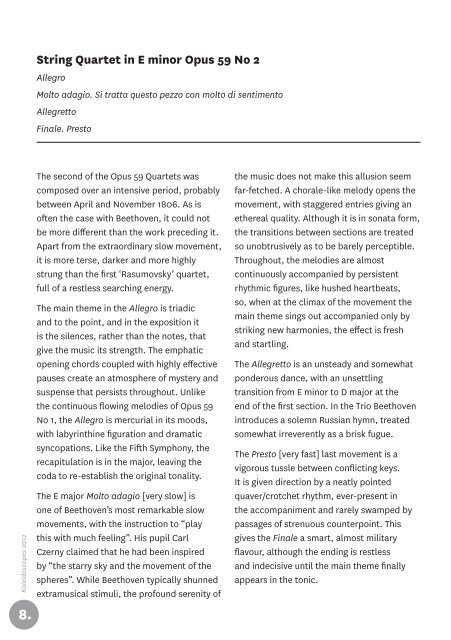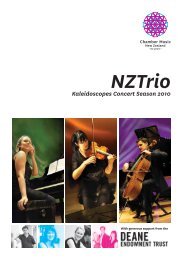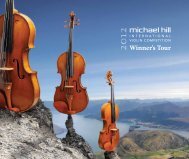BEETHOVEN! - Chamber Music New Zealand
BEETHOVEN! - Chamber Music New Zealand
BEETHOVEN! - Chamber Music New Zealand
Create successful ePaper yourself
Turn your PDF publications into a flip-book with our unique Google optimized e-Paper software.
Kaleidoscopes 2012<br />
8.<br />
String Quartet in E minor Opus 59 No 2<br />
Allegro<br />
Molto adagio. Si tratta questo pezzo con molto di sentimento<br />
Allegretto<br />
Finale. Presto<br />
The second of the Opus 59 Quartets was<br />
composed over an intensive period, probably<br />
between April and November 1806. As is<br />
often the case with Beethoven, it could not<br />
be more diff erent than the work preceding it.<br />
Apart from the extraordinary slow movement,<br />
it is more terse, darker and more highly<br />
strung than the fi rst ‘Rasumovsky’ quartet,<br />
full of a restless searching energy.<br />
The main theme in the Allegro is triadic<br />
and to the point, and in the exposition it<br />
is the silences, rather than the notes, that<br />
give the music its strength. The emphatic<br />
opening chords coupled with highly eff ective<br />
pauses create an atmosphere of mystery and<br />
suspense that persists throughout. Unlike<br />
the continuous fl owing melodies of Opus 59<br />
No 1, the Allegro is mercurial in its moods,<br />
with labyrinthine fi guration and dramatic<br />
syncopations. Like the Fifth Symphony, the<br />
recapitulation is in the major, leaving the<br />
coda to re-establish the original tonality.<br />
The E major Molto adagio [very slow] is<br />
one of Beethoven’s most remarkable slow<br />
movements, with the instruction to “play<br />
this with much feeling”. His pupil Carl<br />
Czerny claimed that he had been inspired<br />
by “the starry sky and the movement of the<br />
spheres”. While Beethoven typically shunned<br />
extramusical stimuli, the profound serenity of<br />
the music does not make this allusion seem<br />
far-fetched. A chorale-like melody opens the<br />
movement, with staggered entries giving an<br />
ethereal quality. Although it is in sonata form,<br />
the transitions between sections are treated<br />
so unobtrusively as to be barely perceptible.<br />
Throughout, the melodies are almost<br />
continuously accompanied by persistent<br />
rhythmic fi gures, like hushed heartbeats,<br />
so, when at the climax of the movement the<br />
main theme sings out accompanied only by<br />
striking new harmonies, the eff ect is fresh<br />
and startling.<br />
The Allegretto is an unsteady and somewhat<br />
ponderous dance, with an unsettling<br />
transition from E minor to D major at the<br />
end of the fi rst section. In the Trio Beethoven<br />
introduces a solemn Russian hymn, treated<br />
somewhat irreverently as a brisk fugue.<br />
The Presto [very fast] last movement is a<br />
vigorous tussle between confl icting keys.<br />
It is given direction by a neatly pointed<br />
quaver/crotchet rhythm, ever-present in<br />
the accompaniment and rarely swamped by<br />
passages of strenuous counterpoint. This<br />
gives the Finale a smart, almost military<br />
fl avour, although the ending is restless<br />
and indecisive until the main theme fi nally<br />
appears in the tonic.





